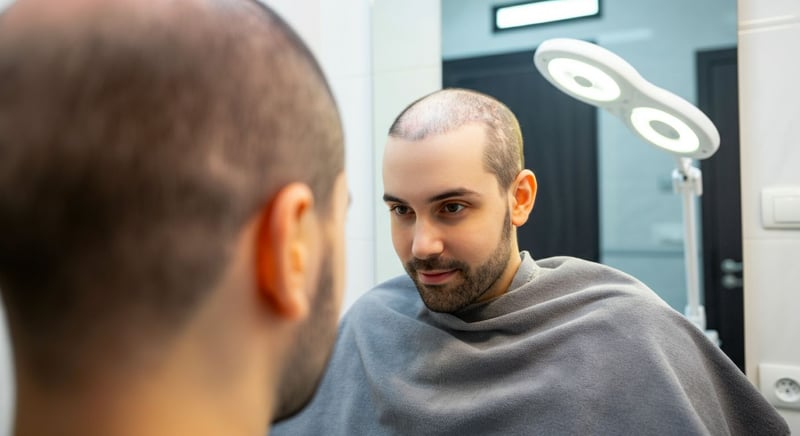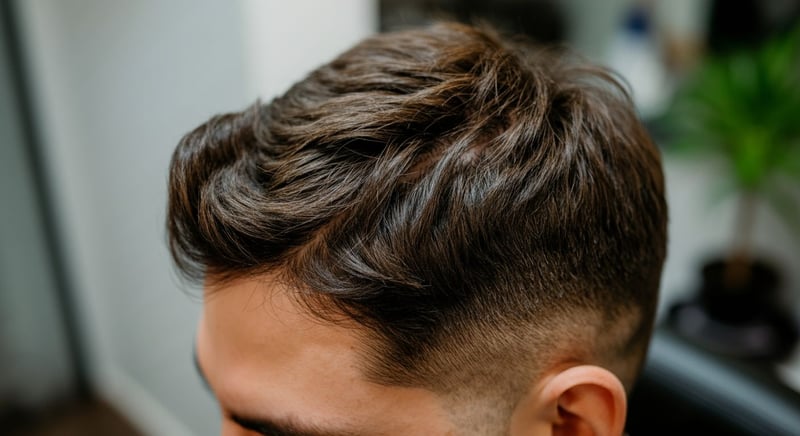Hair Restoration: Unlocking Your Natural Hair's Potential
Unlock the secret to natural, lasting hair restoration with innovative FUE and DHI techniques — regain your confidence today.
Hair loss is a common issue affecting thousands worldwide, leading many to seek effective hair restoration solutions. With advances in medical technology, hair transplantation has emerged as a reliable method to regain lost locks and boost confidence. This article delves into the causes of hair loss, compares popular transplant techniques, and explores post-procedural care to ensure you make an informed decision about your hair restoration journey.
Understanding Hair Loss: Identifying the Root Causes
Exploring the Multifaceted Nature of Hair Loss
Hair loss, a condition impacting millions, manifests differently across individuals, with reasons as varied as our genetic make-up and lifestyle choices. Pinpointing the exact cause is the first step in identifying the appropriate treatment pathway. For instance, while some might experience thinning due to a hereditary condition, others might face it as a result of significant stress or nutritional imbalances. The diagnosis dictates whether the solution lies in medical treatments, lifestyle adjustments, or advanced procedures like hair transplant.
Common Factors Influencing Hair Loss
- Genetic Predisposition: Hereditary factors play a substantial role in determining an individual’s likelihood of experiencing hair loss, particularly androgenetic alopecia, commonly known as male or female pattern baldness.
- Stress and Trauma: Significant emotional or physical stress can trigger temporary hair loss, a condition called telogen effluvium, which disrupts the hair growth cycle and leads to increased shedding.
- Nutritional Deficiencies: Inadequate intake of essential vitamins and minerals, such as iron, zinc, and biotin, can impair hair follicle function, resulting in thinning hair and reduced hair growth.
Innovative Hair Restoration Methods
- Follicular Unit Extraction (FUE): A minimally invasive technique where individual hair follicles are extracted from the donor area and transplanted to the balding areas, resulting in a natural-looking hairline.
- Direct Hair Implantation (DHI): An advanced version of FUE, DHI involves using a specialized pen-like tool to directly implant hair follicles without the need for creating incisions, leading to faster recovery and higher graft survival rates.
- Non-Surgical Options: Treatments like minoxidil and finasteride, alongside laser therapy and platelet-rich plasma (PRP) injections, offer alternatives for those seeking non-invasive hair transplant treatment.

Hair Transplant Techniques: FUE vs. DHI - Which Is Right for You?
Comparing Extraction and Implantation Methods in Hair Restoration
When exploring options for hair restoration, Follicular Unit Extraction (FUE) and Direct Hair Implantation (DHI) represent leading-edge techniques, each with unique advantages. FUE is known for its minimally invasive approach, extracting individual follicular units from the donor area, which reduces scarring and allows for quicker recovery. DHI enhances this process by using a specialized implanter tool that enables precise control over the depth, angle, and direction of each implanted follicle. This advanced method helps minimize trauma to the scalp and ensures a natural-looking density and distribution, aligning perfectly with the patient's original hairline transplant.
Both techniques are performed by skilled surgeons who work to restore not only hair but also confidence. Whether it's addressing thinning temples or creating a fuller beard, the choice between FUE and DHI often depends on individual patient needs and the expertise available at the hair loss clinics. Consulting with a specialist can help determine which method best suits your specific situation.
Advantages of FUE and DHI Techniques
- FUE: The main advantage of FUE is its minimally invasive nature, which results in reduced scarring and faster healing times compared to older, more invasive methods. This makes it an appealing option for those seeking a less disruptive hair restoration journey.
- DHI: DHI excels in precision, allowing for the strategic placement of each hair follicle to match the natural growth pattern and density of the patient's existing hair. The use of the implanter tool also typically contributes to higher graft survival rates.
- Customization: Both FUE and DHI can be tailored to meet the specific needs of each patient, whether they require restoration of the scalp, eyebrows, or beard. This personalized approach ensures results that look natural.
Ideal Candidates for Hair Transplant
- Healthy Individuals With Hair Loss: Ideal candidates are generally healthy individuals experiencing hair loss due to genetics, aging, or specific medical conditions. Good overall health ensures better graft survival and healing.
- Specific Hair Loss Patterns: Those with defined patterns of baldness, such as a receding hairline or thinning crown, often benefit most from hair transplant procedures. These patterns allow surgeons to create a natural-looking restoration.
- Realistic Expectations: Candidates with realistic expectations about the outcomes of hair implants and are committed to following post-operative care instructions tend to be more satisfied with the results.

Is Hair Transplant Permanent? Setting Realistic Expectations
Understanding the Longevity of Hair Transplant Results
Hair transplant procedures are designed to offer a lasting solution to hair loss, but the permanence of the results can be influenced by various factors, including the individual's health, the technique used, and post-operative care. At estethica, both FUE and DHI methods are implemented to ensure durable and natural-looking outcomes that stand the test of time. Following the procedure, adopting a consistent hair care routine and adhering to all aftercare instructions are imperative to maximize the longevity of the transplanted hair. Consistent care helps maintain the health of the scalp and promotes optimal growth of the transplanted follicles.
Choosing a skilled clinic is paramount as well; the expertise of the surgical team directly impacts the success and durability of the hair transplant. Opting for a reputable provider is crucial for ensuring the long-term satisfaction with hair restoration results.
Maximizing the Longevity of Your Hair Transplant
- Adhere to Post-Op Instructions: Following the specific guidelines provided by your estethica surgeon is essential for the survival and growth of the transplanted follicles. These instructions typically include how to wash your hair, which products to use, and activities to avoid.
- Maintain a Healthy Lifestyle: A balanced diet rich in vitamins and minerals, regular exercise, and stress management can improve overall health and support hair growth. For example, incorporating foods high in iron and zinc can promote stronger hair follicles.
- Consider Follow-Up Treatments: Discuss with your doctor the potential benefits of additional treatments such as PRP therapy or laser therapy, which can stimulate hair growth and improve the density of transplanted areas. These treatments are available at reputable hair loss clinics.
Factors Influencing the Success of Hair Transplants
- Surgical Technique: The precision and expertise used in FUE or DHI directly impact the survival rate of transplanted follicles. estethica employs skilled surgeons who are proficient in performing these techniques to ensure optimal results.
- Patient Age and Hair Characteristics: Younger patients and those with certain hair types may experience different outcomes. Hair thickness, color, and curl can influence how well the transplanted hair blends with existing hair.
- Underlying Health Conditions: Certain medical conditions and medications can affect hair growth. It is crucial to disclose your complete medical history to your estethica consultant to assess potential impacts on the hair transplant outcome.

Beyond the Procedure: Essential Hair Loss Treatment and Care Tips
Maximizing Hair Growth After a Hair Transplant
After undergoing a hair transplant, the focus shifts to nurturing the newly implanted follicles to ensure optimal growth and integration. estethica emphasizes a comprehensive aftercare protocol, including patented creams designed to soothe the scalp and promote healing, alongside Platelet-Rich Plasma (PRP) treatments to stimulate follicle strength. These treatments are tailored to individual needs, aiming to enhance the overall health and vitality of the transplanted hair.
Incorporating lifestyle adjustments can further bolster the success of your hair restoration efforts. A diet rich in essential nutrients supports hair health from within, while stress-reduction techniques can prevent stress-related hair shedding. With estethica's advanced treatments and personalized support, patients can achieve lasting improvements in hair density and appearance. For example, consistent care can significantly enhance follicle strength.
Essential Post-Transplant Care Tips
- Gentle Hair Care: Using mild, sulfate-free shampoos is crucial in the weeks following the procedure to avoid irritating the scalp and damaging the newly transplanted follicles. Regularly cleansing your scalp gently with lukewarm water helps keep the area clean and promotes healing.
- Nutritional Support: A diet rich in vitamins, minerals, and proteins provides the building blocks necessary for hair growth. Foods like eggs, spinach, and salmon are excellent sources of nutrients known to support hair health.
- Stress Management: High stress levels can negatively impact hair growth. Practicing relaxation techniques such as yoga, meditation, or even regular walks in nature can help reduce stress and support overall well-being, which in turn benefits hair health.
Integrating Advanced Therapies for Enhanced Results
- PRP Therapy: Platelet-Rich Plasma (PRP) therapy involves injecting a concentration of your own platelets into the scalp to stimulate hair growth and increase hair thickness. This therapy complements the transplant by enhancing the blood supply to the follicles, leading to better growth.
- Laser Therapy: Low-level laser therapy (LLLT) can also be used to stimulate hair follicles and promote growth. Laser devices emit light that is absorbed by the follicles, which can improve cellular metabolism and blood flow, resulting in stronger, healthier hair.
- Topical Treatments: Patented creams and solutions provided by estethica are specifically formulated to soothe the scalp, reduce inflammation, and promote faster healing after a hair transplant treatment. These may include ingredients such as minoxidil or other growth-stimulating compounds.
Advanced FUE and DHI Techniques for Natural-Looking Hair Restoration
Meticulous Post-Procedure Protocols Ensuring Optimal Hair Growth and Scalp Health
Frequently Asked Questions
What are the primary factors that contribute to hair loss?
How do FUE and DHI hair transplant techniques differ, and which is better?
What steps can I take to maximize the longevity of my hair transplant results?
What essential aftercare tips should I follow after a hair transplant?
How is PRP therapy beneficial after a hair transplant procedure?
Ready to explore your aesthetic and healthcare options with world-class experts?
📞 Book Your Free Consultation!